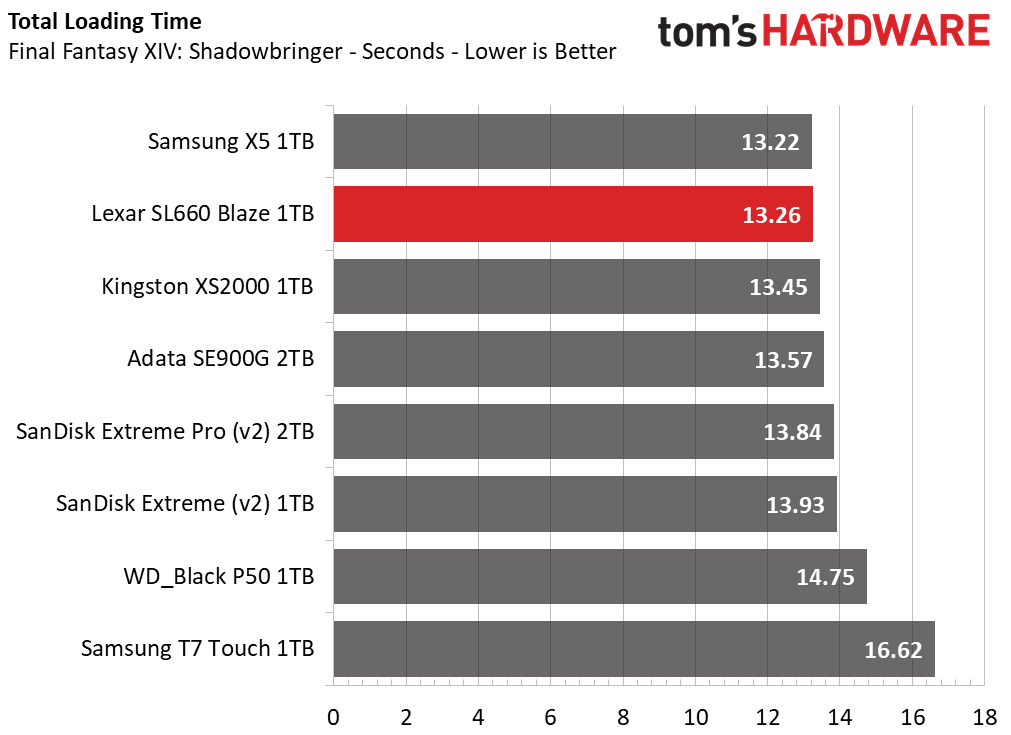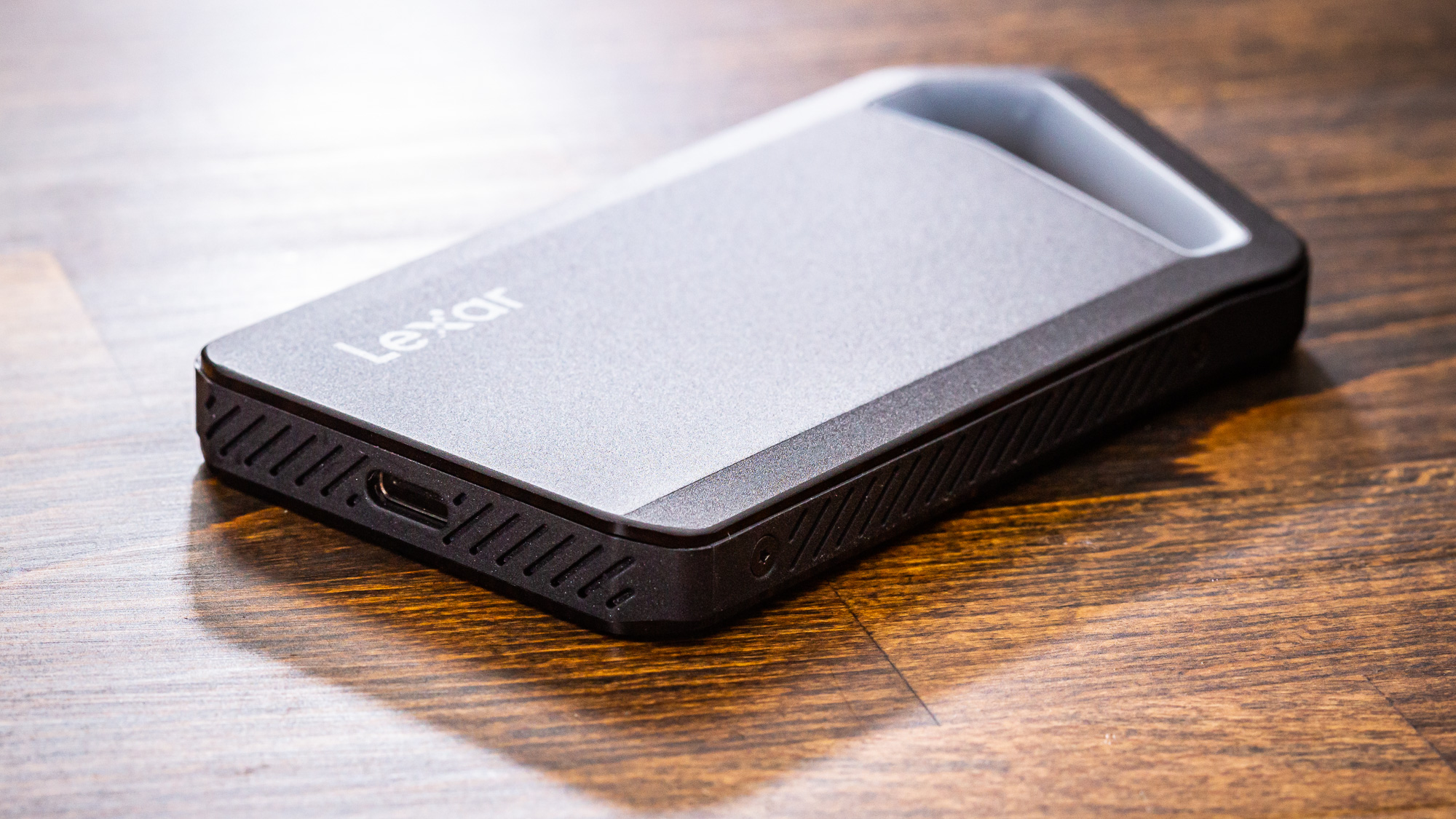Why you can trust Tom's Hardware
Comparison Products
We compare the Lexar SL660 Blaze to other popular portable SSDs including SanDisk’s Extreme and Extreme Pro (both v2), the Samsung X5 and T7, the WD Black P50, the Adata SE900G, and of course the Kingston XS2000. Two of these drives are at the 2TB capacity but this should offer no advantage in this drive class.
Game Scene Loading - Final Fantasy XIV
Final Fantasy XIV Shadowbringers is a free real-world game benchmark that easily and accurately compares game load times without the inaccuracy of using a stopwatch.
The SL660 Blaze is marketed as a gaming drive, so it’s nice to see it delivers a very good result here. SSDs, in general, offer the best loading times, and it can be nice to have a portable option if you’re on the go or if you use a gaming laptop.
Trace Testing – PCMark 10 Storage Benchmark
PCMark 10 is a trace-based benchmark that uses a wide-ranging set of real-world traces from popular applications and everyday tasks to measure the performance of storage devices.
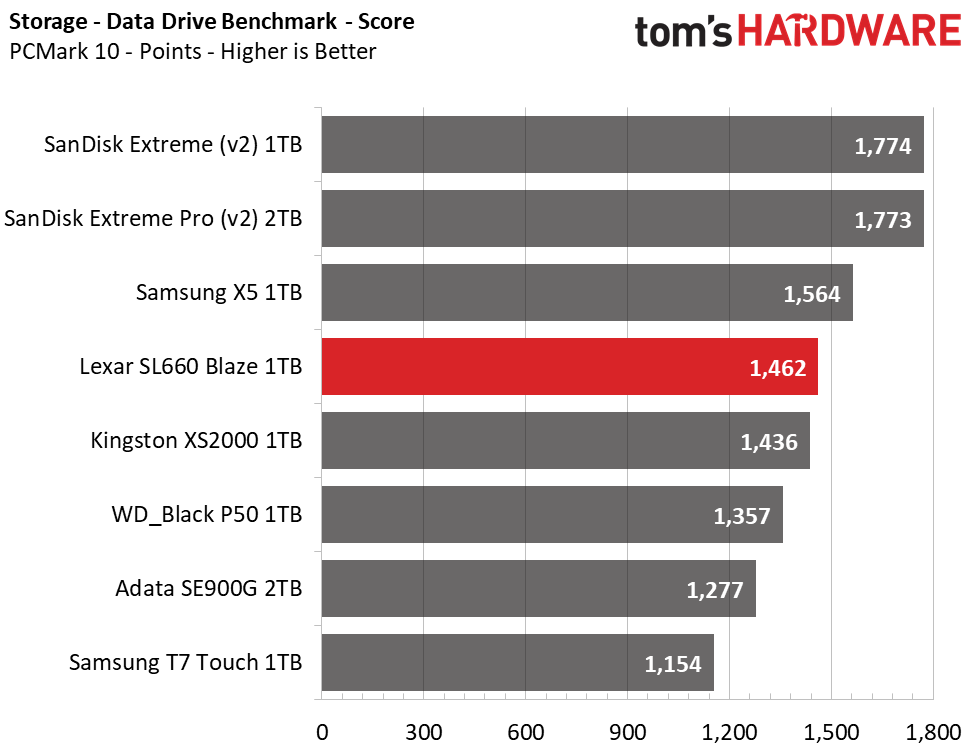
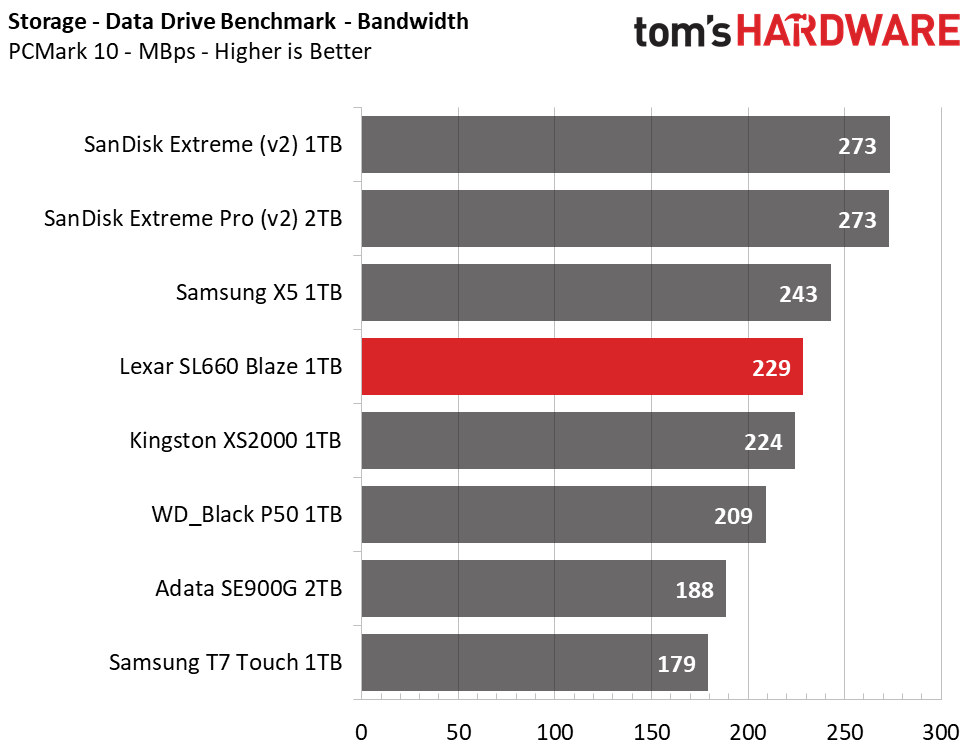
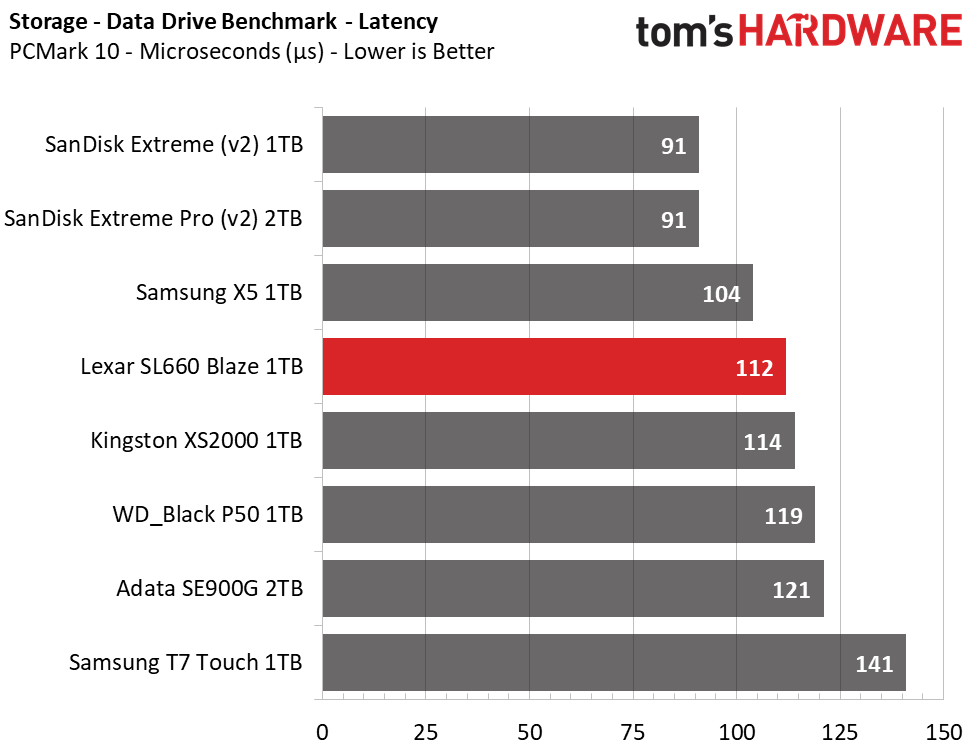
The 1TB SL660 Blaze is in the middle of the pack here, right alongside the Kingston XS2000. We see better results from the SanDisk Extreme Pro v2, which has DRAM, and the Samsung X5, which utilizes Thunderbolt 3 and also has DRAM.
Transfer Rates – DiskBench
We use the DiskBench storage benchmarking tool to test file transfer performance with a custom, 50GB dataset. We copy 31,227 files of various types, such as pictures, PDFs, and videos to a new folder and then follow-up with a reading test of a newly-written 6.5GB zip file.


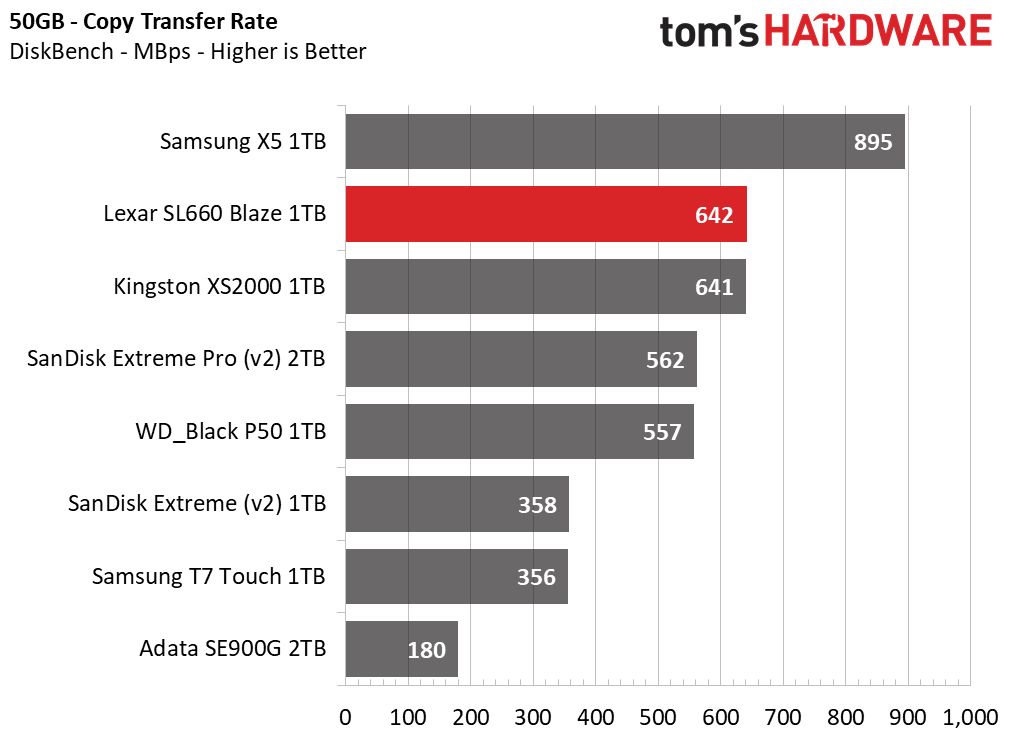
The 1TB SL660 Blaze, along with the XS2000, is on top of the USB-based portable drives. It offers very fast transfer times and is only beaten by the ThunderBolt 3-equipped X5.
Get Tom's Hardware's best news and in-depth reviews, straight to your inbox.
Synthetic Testing - ATTO / CrystalDiskMark
ATTO and CrystalDiskMark (CDM) are free and easy-to-use storage benchmarking tools that SSD vendors commonly use to assign performance specifications to their products. Both of these tools give us insight into how each device handles different file sizes.
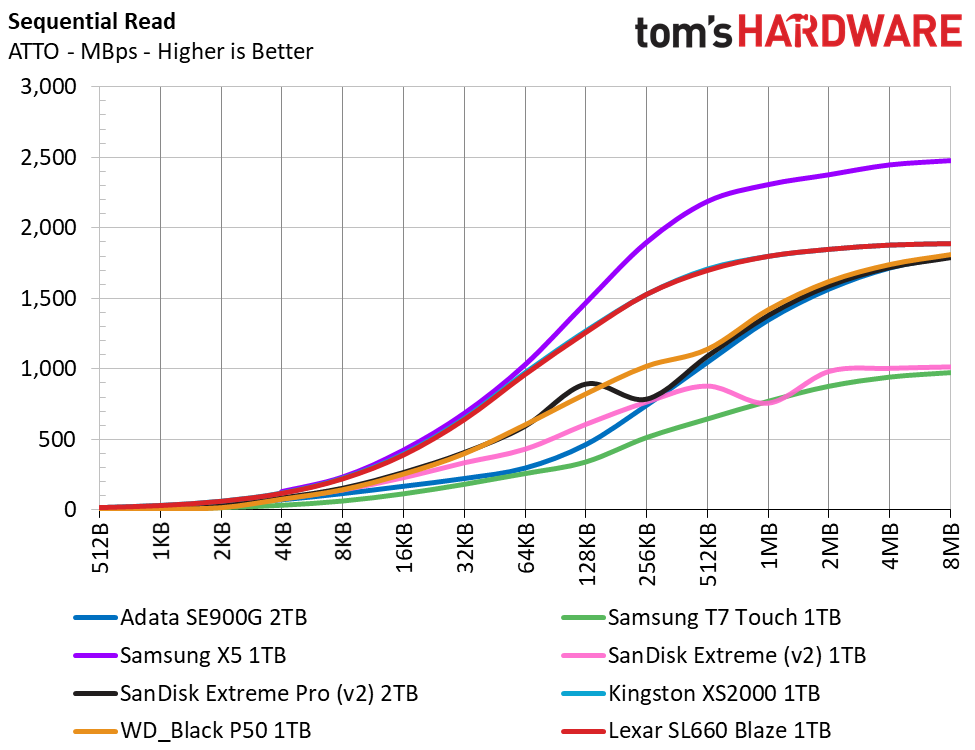
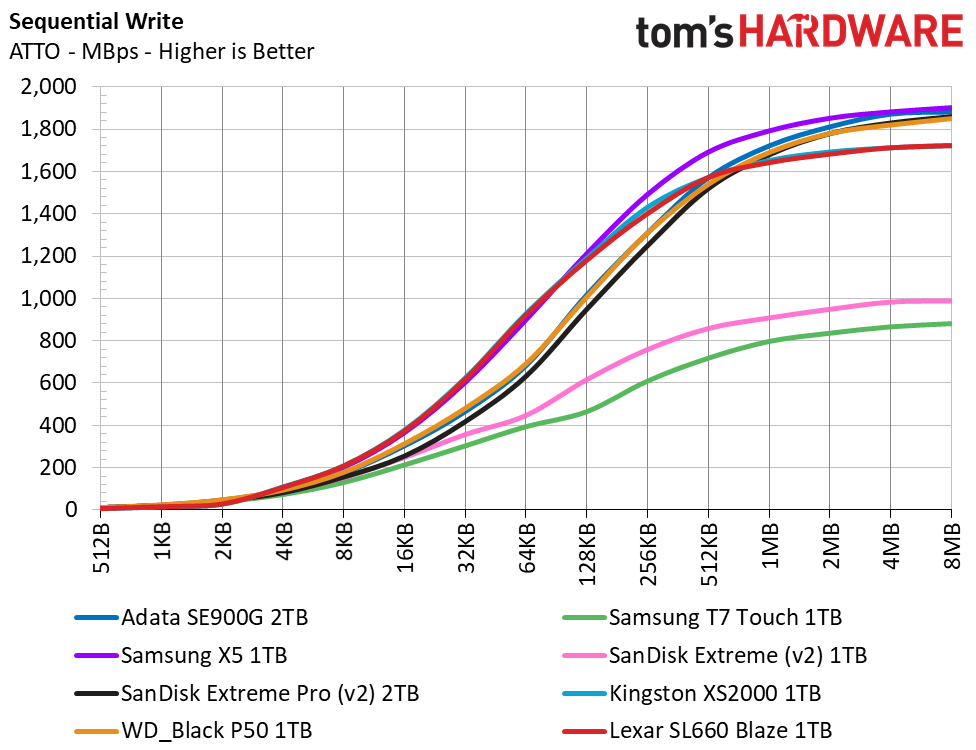
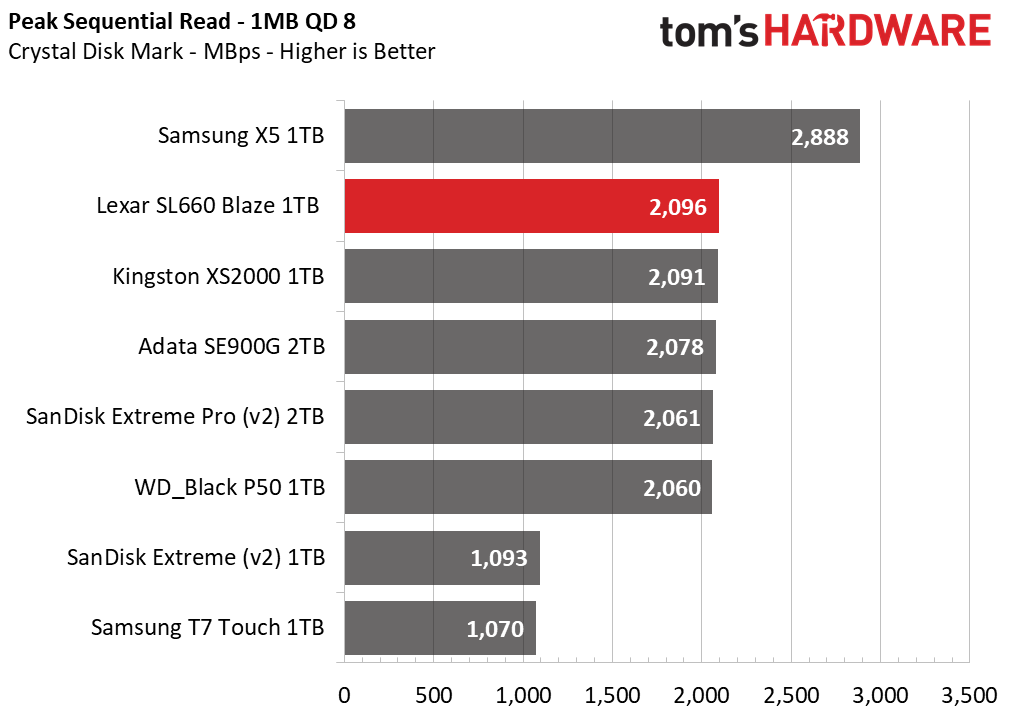
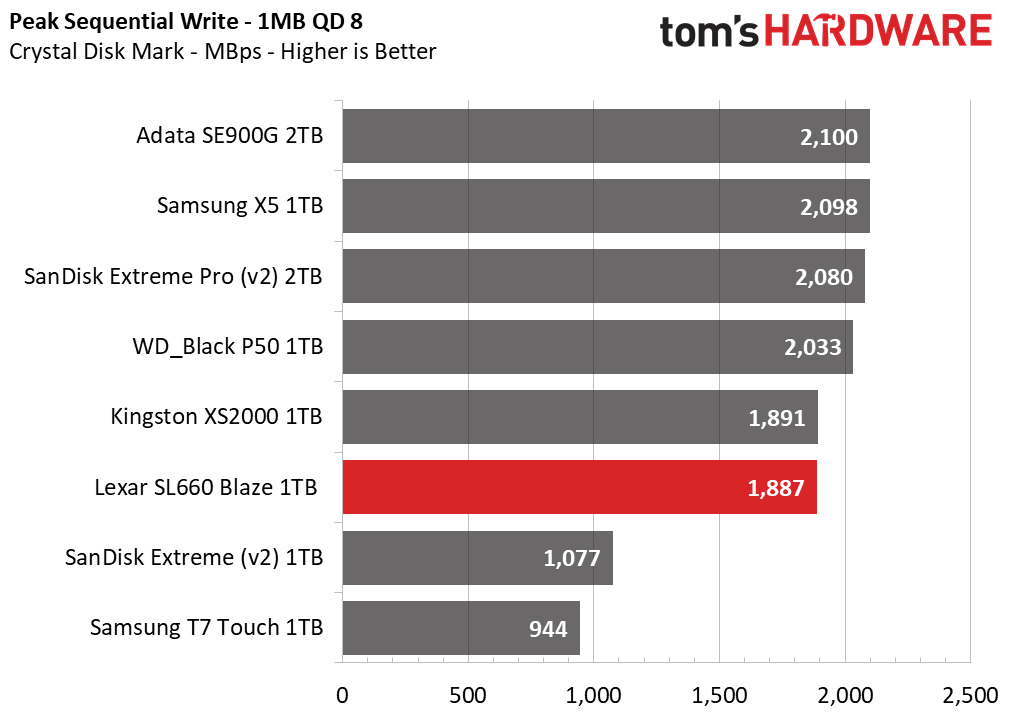
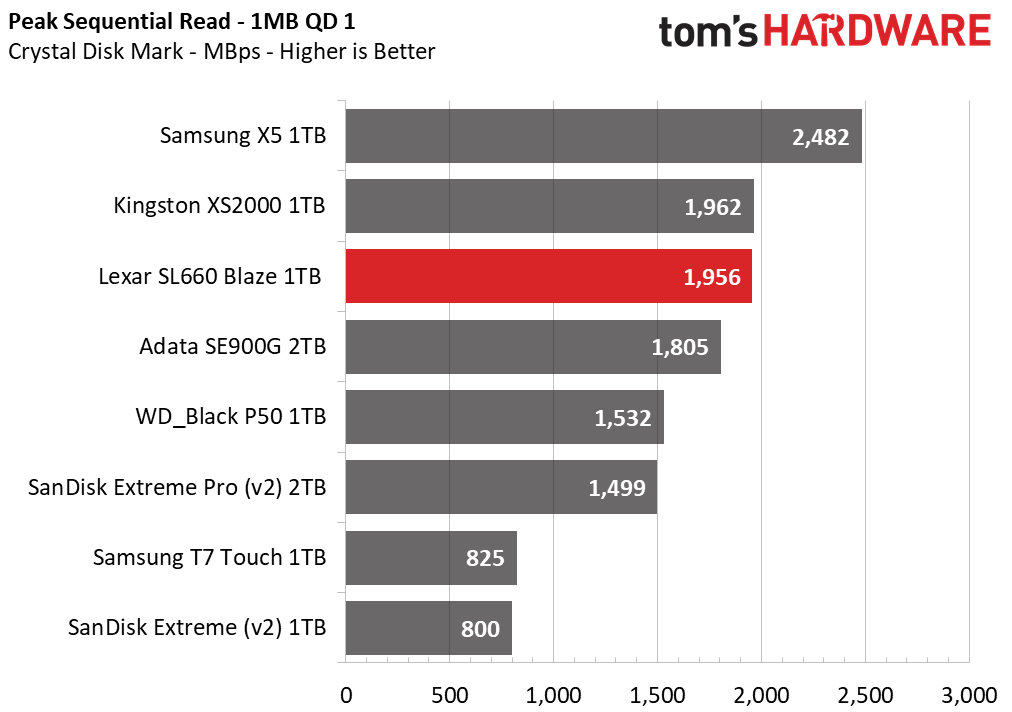
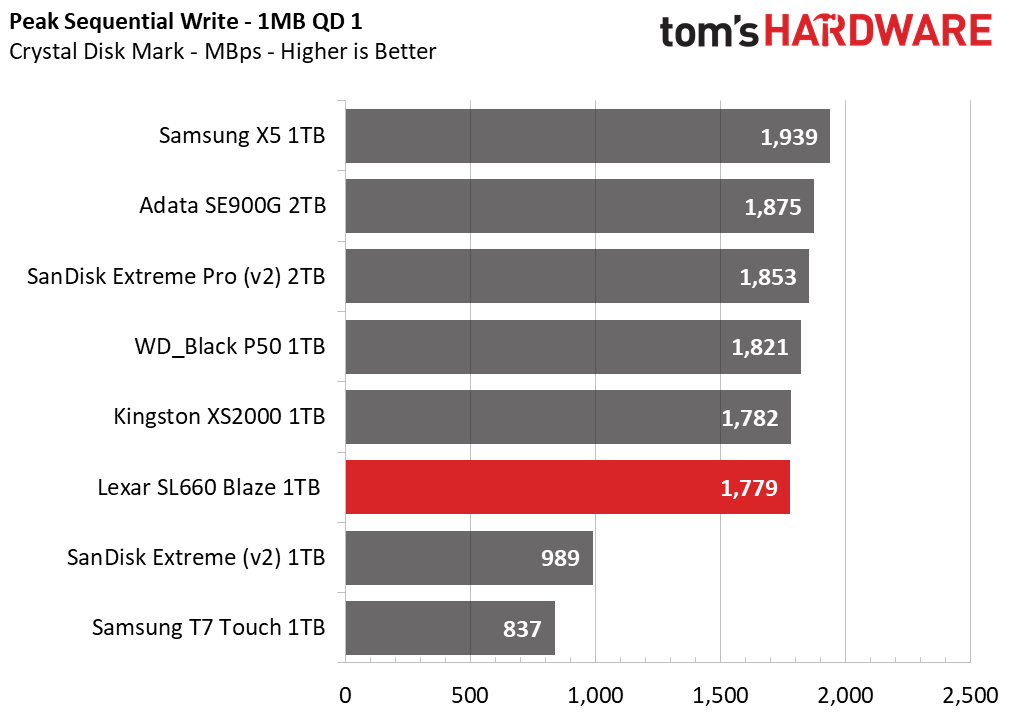
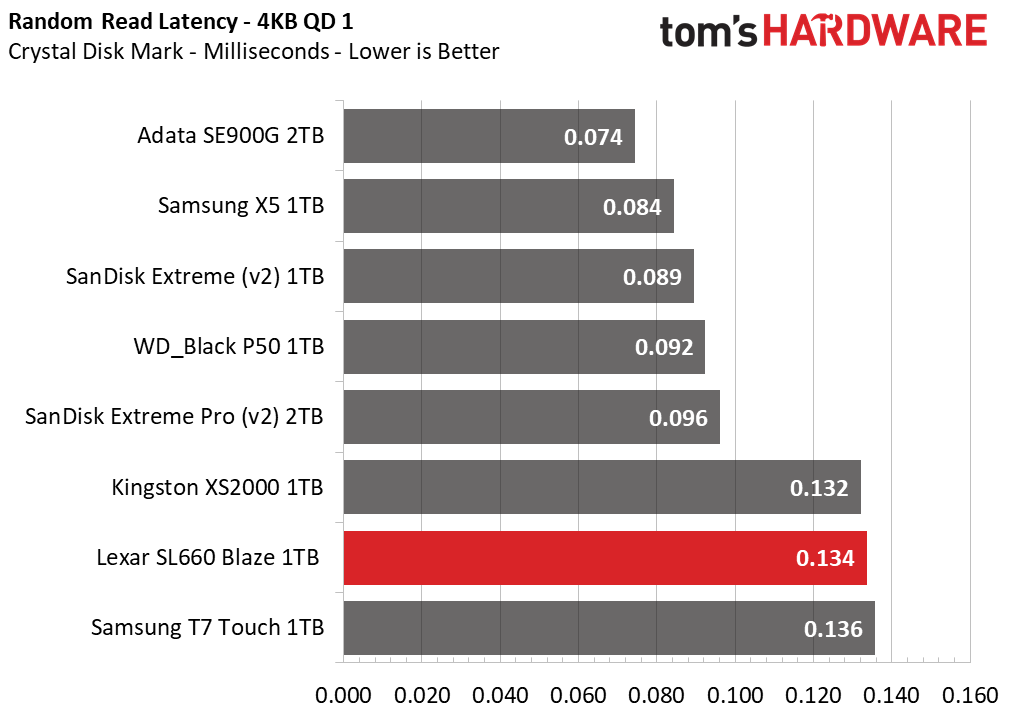
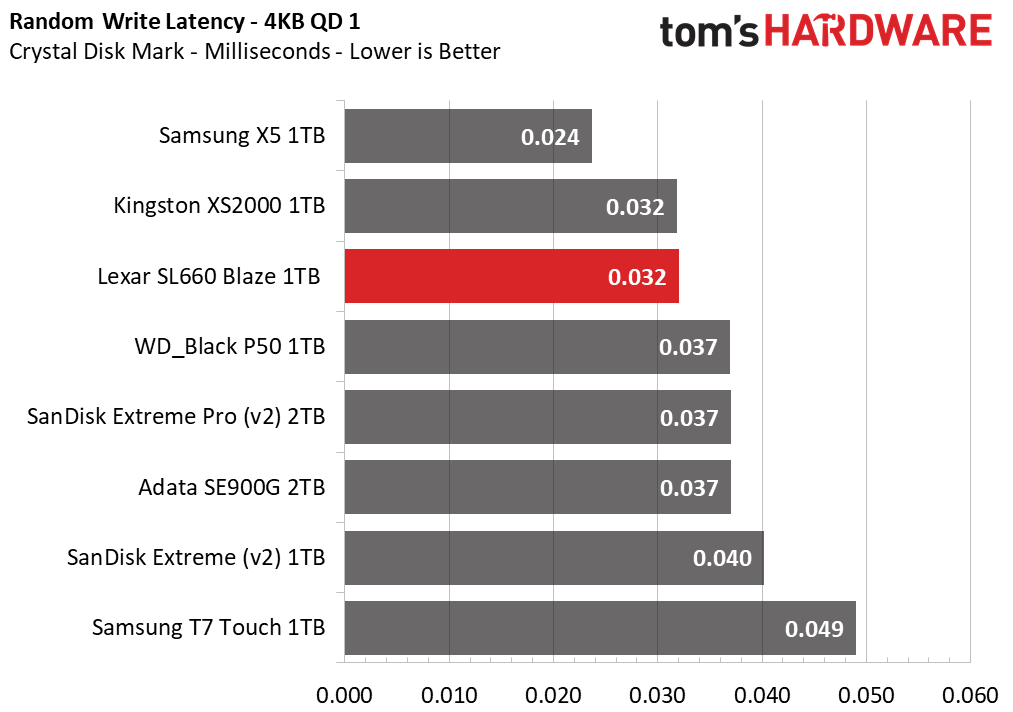


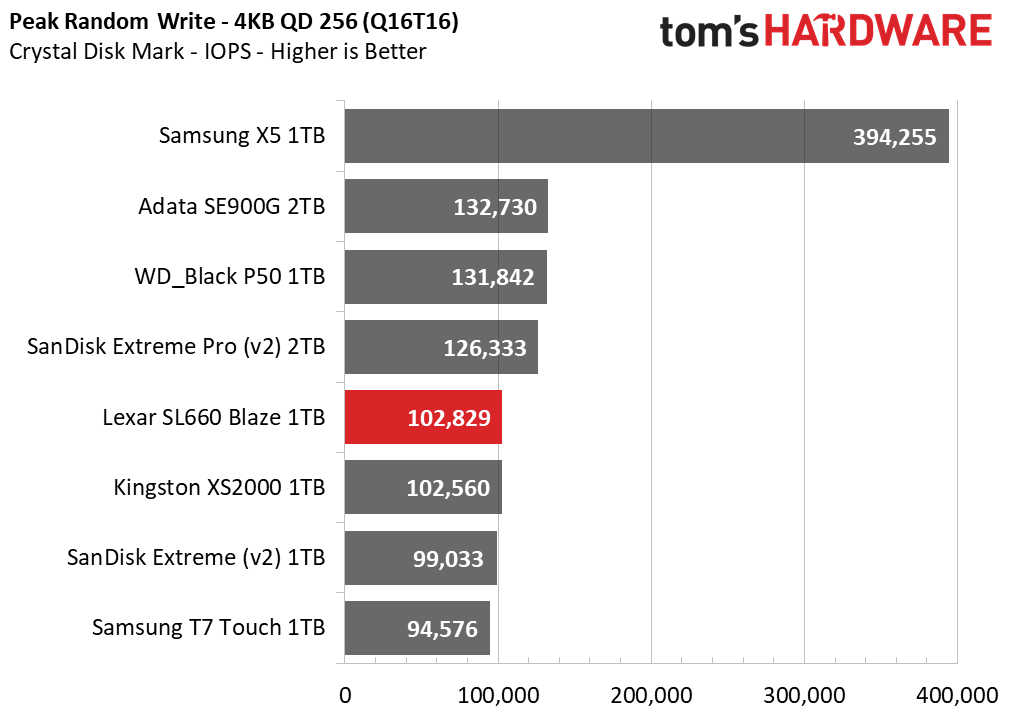
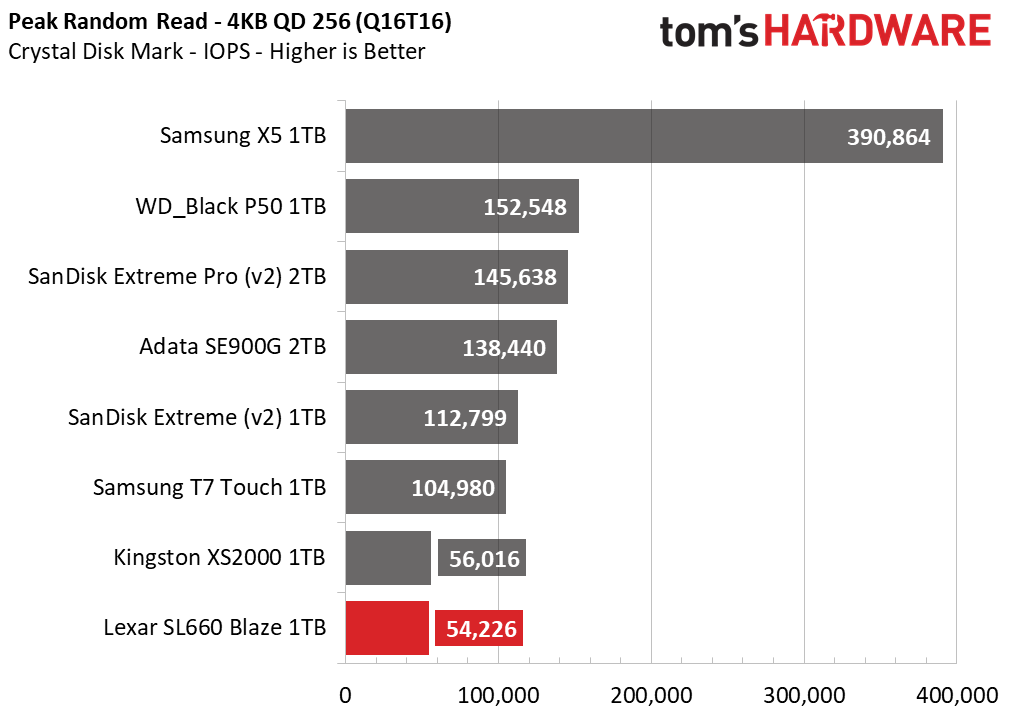
Users transfer files of various sizes regularly with portable drives, so it’s important to look at transfer speeds for different block sizes in ATTO. The SL660 Blaze only comes up short for sequential reads versus the Samsung X5, which again has a ThunderBolt 3 interface. It also falls slightly behind the ASM2364-based drives at larger sequential write sizes, which points to a difference in controller limitations.
CrystalDiskMark, that most popular of SSD benchmarks, just shows the interface's limits for peak sequential reads and writes. We see a bit of a different story with random performance. Random write performance is quite good, and the SL660 Blaze again matches the XS2000 while falling behind only the X5 at low queue depth. Reduced write latency may be a product of the hybrid design, as writes require acknowledgment. However, we see the SM2320 drives falling behind along with Samsung’s T7 Touch during a low queue depth read workload.
This is likely due to the controller being DRAM-less - the same is also true of the T7’s Pablo controller - which can exacerbate the limitations of the interface. Low queue depth random reads are often utilized as a guideline for general user experience, yet we saw the SL660 Blaze do quite well with the Final Fantasy XIV benchmark - at least in comparison to other portable SSDs. There is simply a performance threshold where you get most of the gains of a solid state drive, but portables are limited by interface. This illustrates why a DRAM-less design like the SM2320 can still be optimal for a portable drive, and certainly so for gaming.
Sustained Write Performance, Cache Recovery and Temperature
Official write specifications are only part of the performance picture. Most SSDs implement a write cache, which is a fast area of (usually) pseudo-SLC programmed flash that absorbs incoming data. Sustained write speeds can suffer tremendously once the workload spills outside of the cache and into the "native" TLC or QLC flash. We use Iometer to hammer the SSD with sequential writes for 15 minutes to measure both the size of the write cache and performance after the cache is saturated. We also monitor cache recovery via multiple idle rounds.

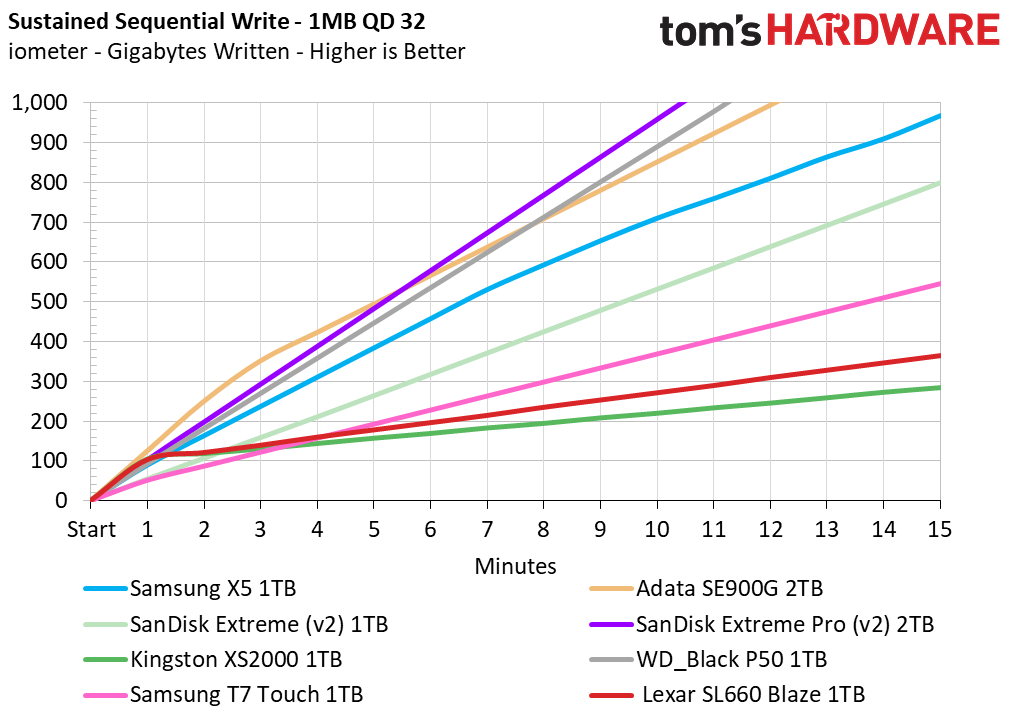
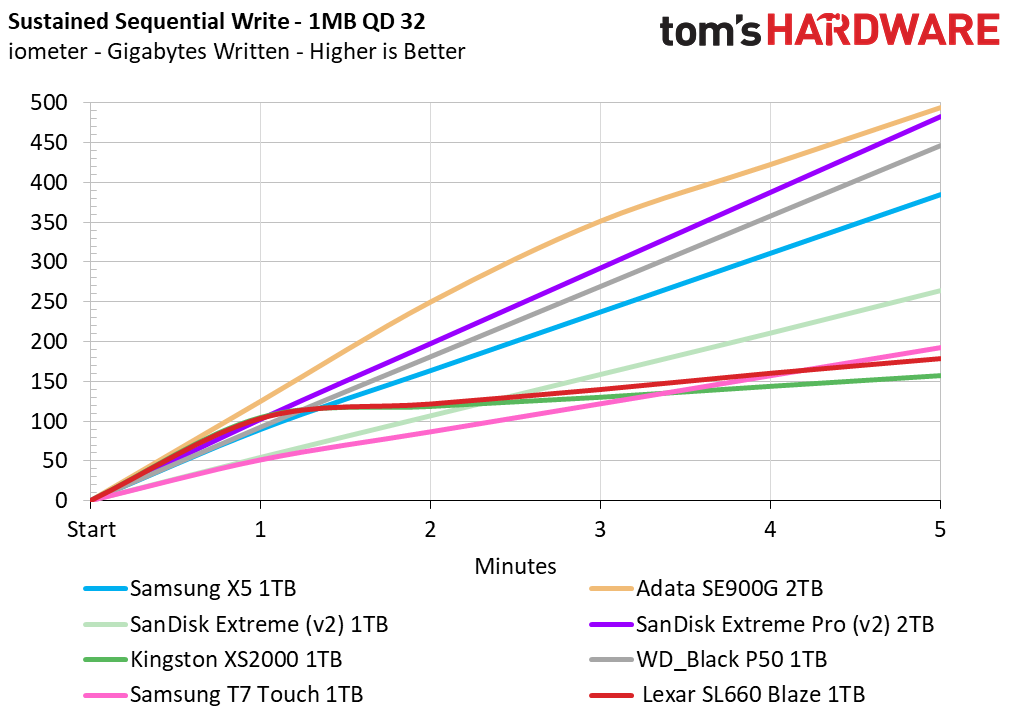
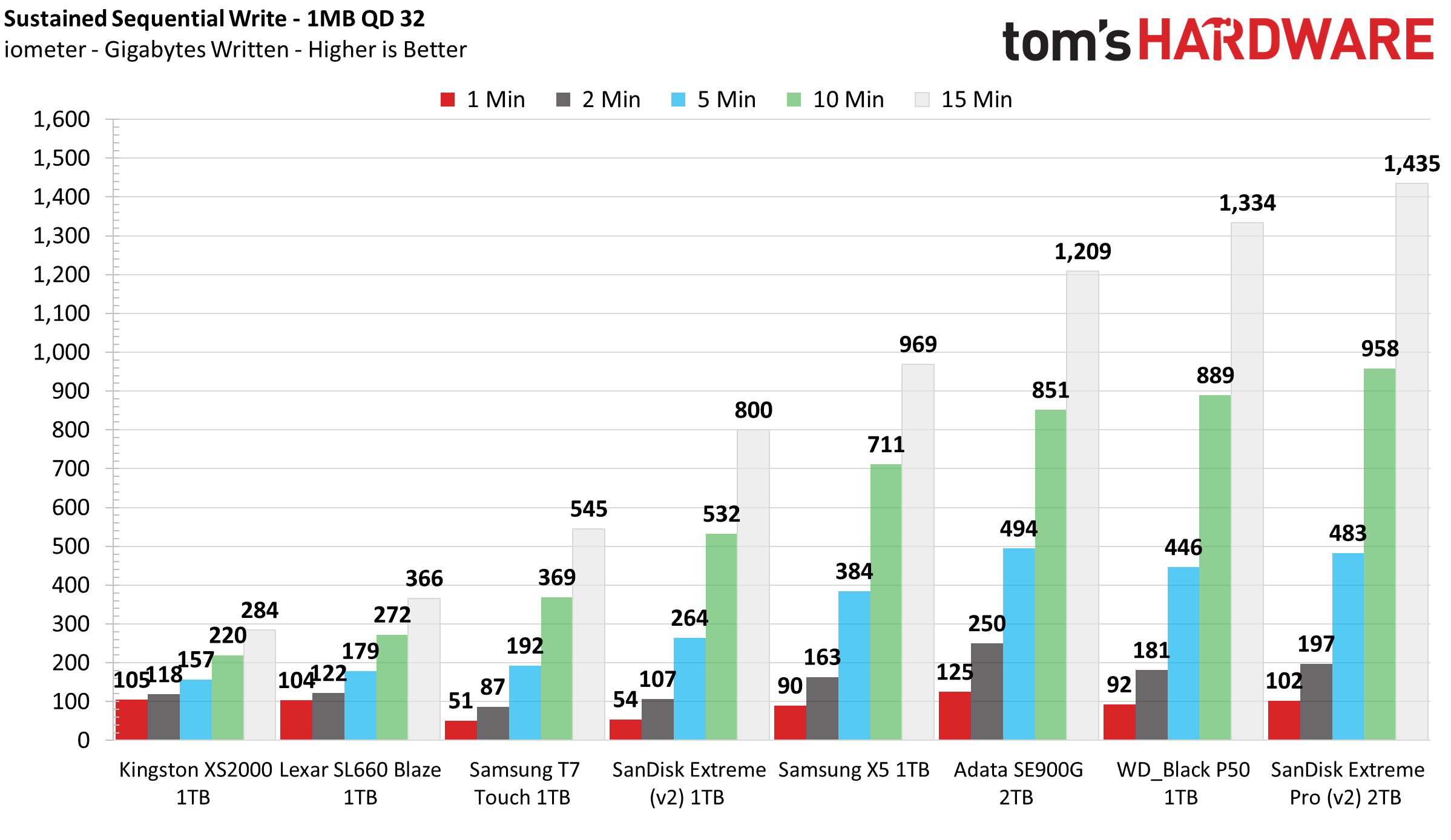
Continuing from the Crystal Disk Mark results above, we can then speculate that a DRAM-less SSD may still have significant shortfalls as a secondary effect. This is clearly the case in the write saturation test.
Our results are very similar to what we saw with the XS2000. The drive writes at maximum speed, or 1.8Gbps, for approximately 55s, for a total cache size of around 100GB. From what we understand these drives utilize a hybrid cache, with 6GB of static and the rest being dynamic.
After the cache is exhausted, the sequential write performance is very erratic. The drive is folding to native TLC which eventually frees up enough SLC for a brief spike in write throughput, before falling back down. Overall post-SLC sequential write bandwidth is around 200MBps, which is certainly not great and is reminiscent of some QLC-based desktop drives. The T7 Touch relies on a much smaller cache but then engages direct-to-TLC. For that reason, it is faster and its more consistent post-SLC performance can out-write the SL660 Blaze and XS2000.
DRAM-less drives tend to have weaker post-SLC performance due to larger SLC cache sizes, fewer flash channels, and an overall design philosophy that benefits from the slower folding state. While the T7 outpaces the SL660 Blaze and XS2000 it still falls behind the rest of the drives in sustained writes, and interface limitations squeeze it with shorter writes.
Cache recovery on the SL660 Blaze was similar to the XS2000, with the static portion recovering relatively rapidly and the dynamic portion requiring more time. However, it’s a fairly reasonable response given how this drive will be used. Those regularly doing large, sustained writes, which could include videographers, for example, might want to look at a different portable drive, but this cache should be adequate for gaming even in a fuller-drive state.
We had good thermal results from the XS2000 but we would expect them to be even better with the SL660 Blaze due to its aluminum case and interior design. This proved to be true as the surface was 5C cooler than the XS2000’s under load, at 31C, with the drive itself reaching around 7C less, or 64C, as measured by an IR gun. We certainly saw no throttling and idle temperatures were also good.
Test Bench and Testing Notes
| CPU | Intel Core i9-11900K |
| Motherboard | ASRock Z590 Taichi |
| Memory | 2x8GB Kingston HyperX Predator DDR4 5333 |
| Graphics | Intel UHD Graphics 750 |
| CPU Cooling | Alphacool Eissturm Hurricane Copper 45 3x140mm |
| Case | Streacom BC1 Open Benchtable |
| Power Supply | Corsair SF750 Platinum |
| OS Storage | WD_Black SN850 2TB |
| Operating System | Windows 10 Pro 64-bit 20H2 |
We use a Rocket Lake platform with most background applications such as indexing, windows updates, and anti-virus disabled in the OS to reduce run-to-run variability. Each SSD is prefilled to 50% capacity and tested as a secondary device. Unless noted, we use active cooling for all SSDs.
Conclusion
It is difficult for us not to compare the Lexar SL660 Blaze to the Kingston XS2000 because the internal hardware is similar, and our test results point out plenty of similarities. The SL660 Blaze has a higher price point, which is sensible as it offers more than the XS2000. For example, it comes with an extra cable, a detachable stand, RGB functionality, and software support that includes encryption. It maintains shock resistance but is also larger and weighs more. In a sense, this makes it less portable, but the aluminum body and overall design make it more attractive. Plus, it remains sufficiently convenient.
This is being marketed as a gaming drive which tends not to mean a whole lot in the SSD space — for now. However, the angular design and presence of RGB are probably sufficient to match the requirements of such a moniker. The detachable stand is also a nice feature when considering the possibilities of portable gaming, even if used with a console.
The Sl600's warranty is strong and the drive feels durable, particularly with the pouch, which we feel is a strong selling point if you’re moving the drive around a lot. Although we question the usefulness of software encryption with a gaming drive, software support is a nice touch, but there are other options available that don’t require Lexar's proprietary software. We wouldn’t mind some OEM software for drive cloning, though.
Aside from some minor pitfalls, the SL600's performance is actually not bad for a portable drive. The one area it does fall short is during sustained, sequential write workloads, which exhibit very poor post-cache performance. The cache design itself is robust even if the cache is not particularly large, but this issue will be more troublesome with a fuller drive. While this is not usually a problem for gaming, if you also want to also use this drive to transfer files, particularly larger ones, some alternatives are more attractive in terms of speed and consistency.
Therefore, the SL660 Blaze’s traits are a bit of a double-edged sword. You don’t really need anything special for gaming, so what you are really paying for — versus, say, the XS2000 — is basically aesthetics. The extra cable and the standalone dock are useful additions but may be of situational use. It’s possible to get a cheaper drive if performance is your top priority, making this a luxury item.
ADATA’s SE900G also offers RGB and the extra cable but appears to have a lower MSRP. Is it worth a premium for the dock and Lexar’s software package? Probably not, but we do feel Lexar did a good job of making a product with a premium feel, although we would have liked to see a 2TB option given the size of games these days. That being said, the dock might be useful for certain users.
If you want a portable SSD with a “gaming” feel, something that also feels a bit premium with the aluminum enclosure, pouch, stand, and RGB, then this is the ticket. We feel the market is inundated with gaming-oriented SSDs that are really an excuse to charge more for aesthetics and semi-useful features. We will say that it’s nice Lexar includes a ton of accessories, but someone willing to do a bit of legwork can likely find something just as good for less money. The Lexar SL660 Blaze is for the gamer who has everything.
MORE: Best SSDs
MORE: How We Test HDDs And SSDs
MORE: All SSD Content

Shane Downing is a Freelance Reviewer for Tom’s Hardware US, covering consumer storage hardware.
